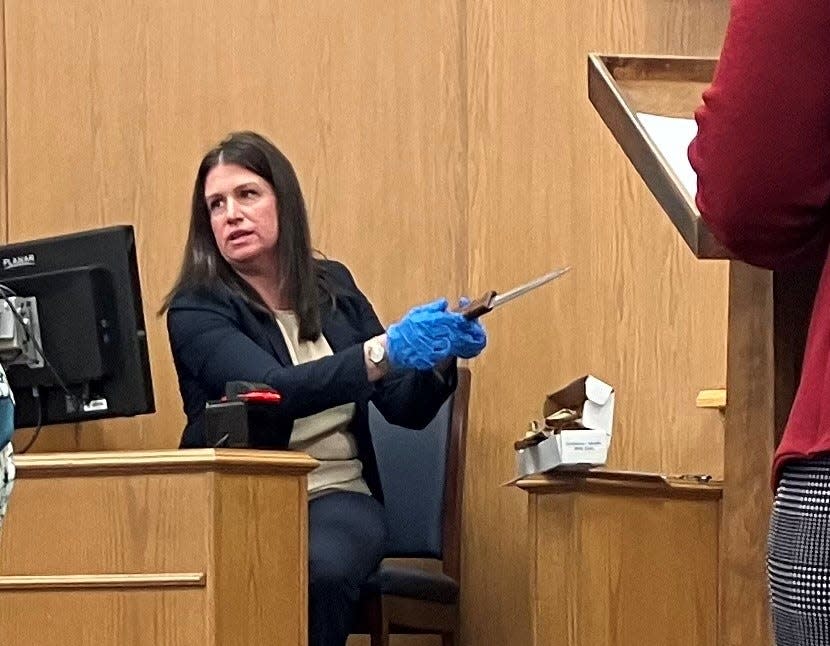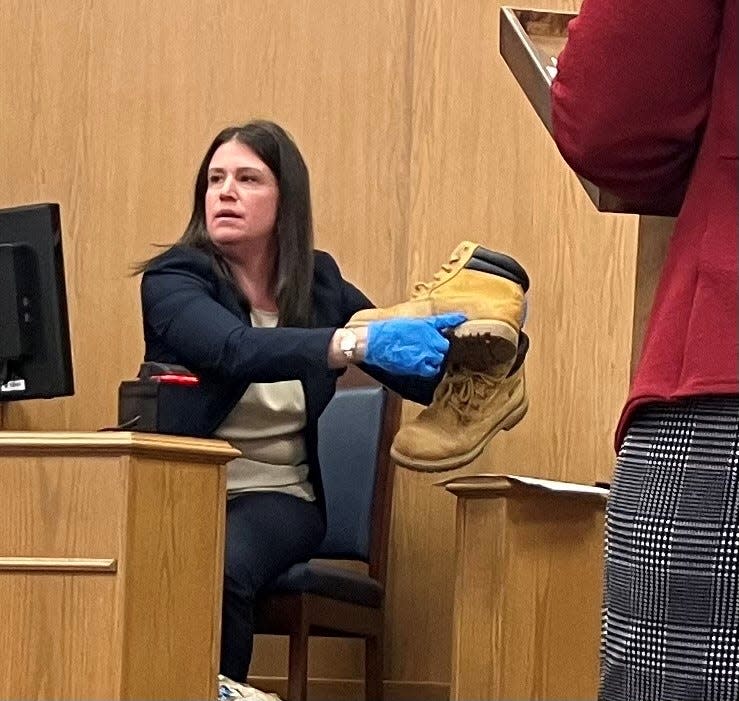DNA expert testifies about evidence found on kitchen knife possibly used in Perrine murder

NEWARK − A kitchen knife that might have been used to kill Debra Perrine contained what appeared to be her blood on the blade and what appeared to be her son’s DNA on the handle, a DNA analyst testified Monday.
The knife was found between the mattress and box spring on Debra Perrine's bed when police searched the home of the missing woman on Dec. 23, 2022. David Perrine, her son, is on trial in Licking County Common Pleas Court, charged with her murder.
Investigators found Debra Perrine, 67, buried in a shallow grave in the backyard of her home at 207 Darlene Drive on Dec. 29, which was 12 days after she had last been seen. She had obvious signs of trauma, police said.
Licking County Prosecutor Jenny Wells has said they intend to prove David Perrine killed his mother between Dec. 17 and Dec. 22, 2022.
Devonie Herdeman, a DNA analyst with the Ohio Bureau of Criminal Investigation, testified about the results of comparisons of DNA found on items at the scene with samples from the victim and the defendant.

The Licking County deputy coroner testified Monday that Debra Perrine's death in December 2022 was a homicide, and the Newark woman suffered blunt force trauma to her head and 14 stab wounds to her face, neck and upper chest.
"The knife was found to be presumptive positive for blood," Herdeman said. "Item 8.2 was a swab taken from the blade. DNA profile was consistent with Debra Perrine. And then (item) 8.6 was a swab taken from the handle. That was a mixture, with one major contributor, and that major contributor was consistent with David Perrine."
Defense attorney Kristin Burkett asked Herdeman, “If that was a knife that was used regularly in the house by somebody who lived there, it could -- you don’t have any idea when that got there?”
Herdeman responded, “Correct. Testing does not tell you when the DNA got there. It doesn’t tell you how it got there or how long it’s been there. So, if it was an item in the house, I would expect that the people who live in that house who use that knife regularly to be on the handle of that item.”
Debra Perrine and David Perrine both lived in the house.
A juror asked if washing an item removes the DNA.
"DNA is sensitive to detergent, and it can be manually removed,' Herdeman said. "If a person is using their hands to rinse something off, they could just be redepositing their own DNA on it. If it was in a dishwasher, it could have removed DNA due to the heat and the detergent. If touch DNA is on there, it could certainly be removed. Sometimes, stains can be left behind."
Debra Perrine’s DNA, presumably from blood, was also present on the mattress, foam mattress pad, a pillowcase, and size 11 work boots worn by David Perrine.
David Perrine's DNA was also found on one boot, the foam mattress pad and a sweatshirt.
Deputy Coroner Dr. Charles Jeffrey Lee testified the cause of death was internal hemorrhage and bleeding outside of the body, and the manner of death was homicide.
Lee said Debra Perrine suffered blunt force injuries to her head – leaving bruises on her face, left cheek, upper lip, ear lobe and bridge of the nose. There were eight or nine bleeding areas between the scalp and skull, but she was alive when the injuries occurred, he said.
Blunt force trauma to her head could have been caused by anything not leaving specific patterns, Lee said.
Wells asked if a PlayStation found broken and in a burn pit in the backyard could have been the weapon.
“It could have,” Lee said. “Not the corner or edge, but the flat area.”
Sufficient DNA was not available from the PlayStation because it had been outside in elements, including snow, rain and sun.
The 14 stab wounds included several quite deep, hitting the esophagus, carotid artery, trachea and spinal column.
Lee said all the stab wounds could have been caused by the kitchen knife, which had a broken tip.
“The injuries were consistent with this knife, but you don’t know whether it was this knife,” Lee said.
740-973-4539
Twitter: @kmallett1958
This article originally appeared on Newark Advocate: DNA expert testifies about evidence on knife possibly used in murder
